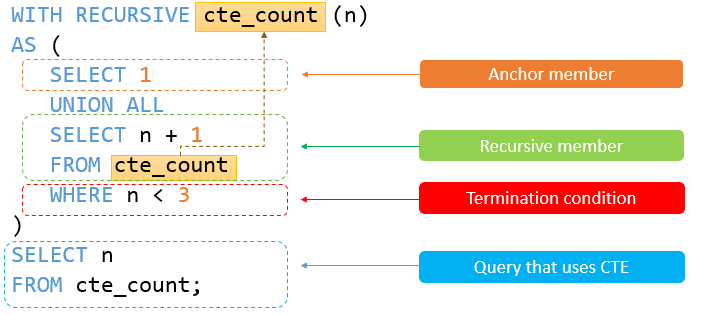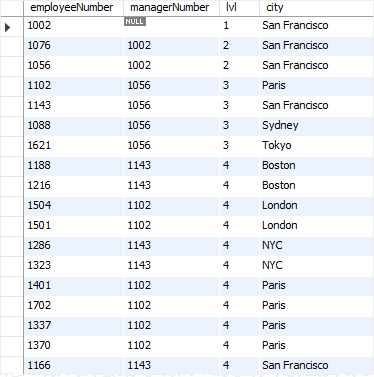MySQL Recursive CTE
From http://www.mysqltutorial.org/mysql-recursive-cte
Introduction to MySQL recursive CTE
Notice that common table expression or CTE only available in MySQL version 8.0 or later. Therefore, you should have the right version of MySQL installed in order to use the statements in this tutorial.
A recursive common table expression (CTE) is a CTE that has a subquery which refers to the CTE name itself. The following illustrates the syntax of a recursive CTE
A recursive CTE consists of three main parts:
- An initial query that forms the base result set of the CTE structure. The initial query part is referred to as an anchor member.
- A recursive query part is a query that references to the CTE name, therefore, it is called a recursive member. The recursive member is joined with the anchor member by a
UNION ALLorUNION DISTINCToperator. - A termination condition that ensures the recursion stops when the recursive member returns no row.
The execution order of a recursive CTE is as follows:
- First, separate the members into two: anchor and recursive members.
- Next, execute the anchor member to form the base result set (
R0) and use this base result set for the next iteration. - Then, execute the recursive member with
Riresult set as an input and makeRi+1as an output. - After that, repeat the third step until the recursive member returns an empty result set, in other words, the termination condition is met.
- Finally, combine result sets from R0 to Rn using
UNION ALLoperator.
Recursive member restrictions
The recursive member must not contain the following constructs:
- Aggregate functions e.g., MAX, MIN, SUM, AVG, COUNT, etc.
- GROUP BY clause
- ORDER BY clause
- LIMIT clause
- DISTINCT
Note that the above constraint does not apply to the anchor member. Also, the prohibition on
DISTINCT applies only when you use UNION operator. In case you use the UNION DISTINCT operator, the DISTINCT is permitted.
In addition, the recursive member can only reference the CTE name once and in its
FROM clause, not in any subquery.Simple MySQL recursive CTE example
See the following simple recursive CTE example:
In this example, the following query:
is the anchor member that returns 1 as the base result set.
The following query
is the recursive member because it references to the name of the CTE which is
cte_count.
The expression
n < 3 in the recursive member is the termination condition. Once n equals 3, the recursive member returns an empty set that will stop the recursion.
The following picture illustrates the elements of the CTE above:

The recursive CTE returns the following output:

The execution steps of the recursive CTE is as follows:
- First, separate the anchor and recursive members.
- Next, the anchor member forms the initial row (
SELECT 1) therefore the first iteration produces 1 + 1 = 2 with n = 1. - Then, the second iteration operates on the output of the first iteration (2) and produces 2 + 1 = 3 with n = 2.
- After that, before the third operation ( n = 3), the termination condition (
n < 3) is met therefore the query stops. - Finally, combine all result sets 1, 2 and 3 using the
UNION ALLoperator
Using MySQL recursive CTE to traverse the hierarchical data
We will use the
employees table in the classicmodels sample database for the demonstration.
The
employees table has the reportsTo column that references to the employeeNumber column. The reportsTo column stores the ids of managers. The top manager does not report to anyone in the company’s organization structure, therefore, the value in the reportsTo column is NULL.
You can apply the recursive CTE to query the whole organization structure in the top-down manner as follows:
Let’s break the query into smaller parts to make it easier to understand.
First, form the anchor member by using the following query:
This query (anchor member) returns the top manager whose
reportsTo is NULL.
Second, make the recursive member by reference to the CTE name, which is
employee_paths in this case:
This query ( recursive member) returns all direct reports of the manager(s) until there are no more direct reports. The if the recursive member returns no direct reports, the recursion stops.
Third, the query that uses the
employee_paths CTE joins the result set returned by the CTE with the offices table to make the final result set.
The following is the output of the query:


Comments
Post a Comment